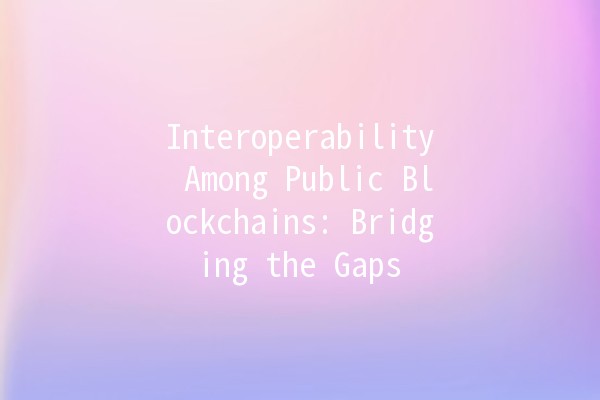
In the world of blockchain technology, the interoperability of public blockchains has become a pressing topic of discussion. As the crypto ecosystem expands, the ability of different blockchain networks to communicate and transact with one another is crucial for the growth and adoption of decentralized applications (dApps). In this article, we will delve into what blockchain interoperability means, explore the benefits and challenges associated with it, and provide actionable tips to improve user experience within this interoperable landscape.
Understanding Blockchain Interoperability
Blockchain interoperability refers to the ability of different blockchain networks to share information and execute transactions without the need for intermediaries. This capability allows data and assets to move seamlessly across networks, creating a more integrated and efficient ecosystem. With numerous blockchain platforms, such as Ethereum, Binance Smart Chain, and Cardano, each offering unique features and functionalities, the need for interoperability becomes increasingly significant.
Benefits of Interoperability

Challenges in Achieving Interoperability
While the benefits of interoperability are clear, several challenges must be addressed to realize its potential:
Enhancing Productivity through Interoperability
To assist users in navigating the challenges of public blockchain interoperability and to enhance productivity, here are five practical tips:
Many projects are developing crosschain protocols to facilitate communication between different blockchains. For instance, using platforms like Polkadot and Cosmos, which specifically focus on creating interconnected networks, can allow developers to build applications that thrive in an interoperable environment.
Example: The Polkadot network uses a unique architecture called "parachains" to connect various blockchain networks. Developers can deploy their dApps on one parachain while leveraging functionalities from other chains within the ecosystem.
Decentralized exchanges allow users to trade digital assets across different blockchains without relying on centralized intermediaries. Utilizing DEX can increase liquidity and accessibility while reducing barriers for users.
Example: Platforms like Thorchain enable users to swap assets across different blockchains like Bitcoin, Ethereum, and Litecoin seamlessly.
Encouraging users to adopt wallets that support multiple blockchain networks can simplify asset management. Users can store, send, and receive tokens from various chains in one wallet, enhancing their experience.
Example: Multicurrency wallets such as Trust Wallet or Atomic Wallet offer support for numerous blockchains, allowing users to manage assets without switching between several wallets.
Participating in developer communities focused on blockchain interoperability can provide valuable insights and resources. By connecting with other developers, one can learn about best practices and innovations in the field.
Example: Platforms like GitHub host numerous projects and discussions related to interoperability. Engaging with these communities can keep developers updated on the latest trends, tools, and approaches.
When exploring interoperability solutions, it is crucial to prioritize security audits and risk management strategies. Collaborate with security experts to identify potential vulnerabilities in crosschain protocols and ensure compliance with the latest security practices.
Example: Security firms like Quantstamp provide auditing services specifically for smart contracts and blockchain networks, helping developers secure their interoperable projects.
Frequently Asked Questions
Blockchain interoperability aims to create seamless communication between different blockchain networks, allowing assets and data to be easily exchanged. This enhances the user experience, improves liquidity, and fosters innovation across the ecosystem.
Projects such as Polkadot, Cosmos, and Chainlink are at the forefront of blockchain interoperability. These projects use unique protocols and mechanisms to connect various blockchain networks, enabling crosschain functionalities.
While interoperability can improve security through audits and validations, it can also introduce new vulnerabilities. Ensuring that crosschain solutions are audited and follow security best practices is crucial to mitigate these risks.
As blockchains become more interconnected, it may prompt regulators to take a closer look at crosschain transactions. Ensuring compliance and understanding the regulatory landscape is essential for projects focusing on interoperability.
Decentralized exchanges (DEX) facilitate the trading of digital assets across multiple blockchains without centralized intermediaries. This enhances liquidity, allows for easier access to various assets, and simplifies trading processes for users.
Users should engage with established projects that prioritize security audits and transparent practices. Reviewing community feedback, conducting research, and utilizing wallets that support multichain functionality can also enhance security.
The landscape of blockchain interoperability is evolving rapidly, presenting vast opportunities for users and developers alike. By understanding its benefits and challenges, and implementing practical strategies, stakeholders can enhance their experience and contribute to a more interconnected blockchain ecosystem. The journey to achieving robust interoperability is ongoing, and its success will significantly impact the future of decentralized applications and the broader adoption of blockchain technology.

